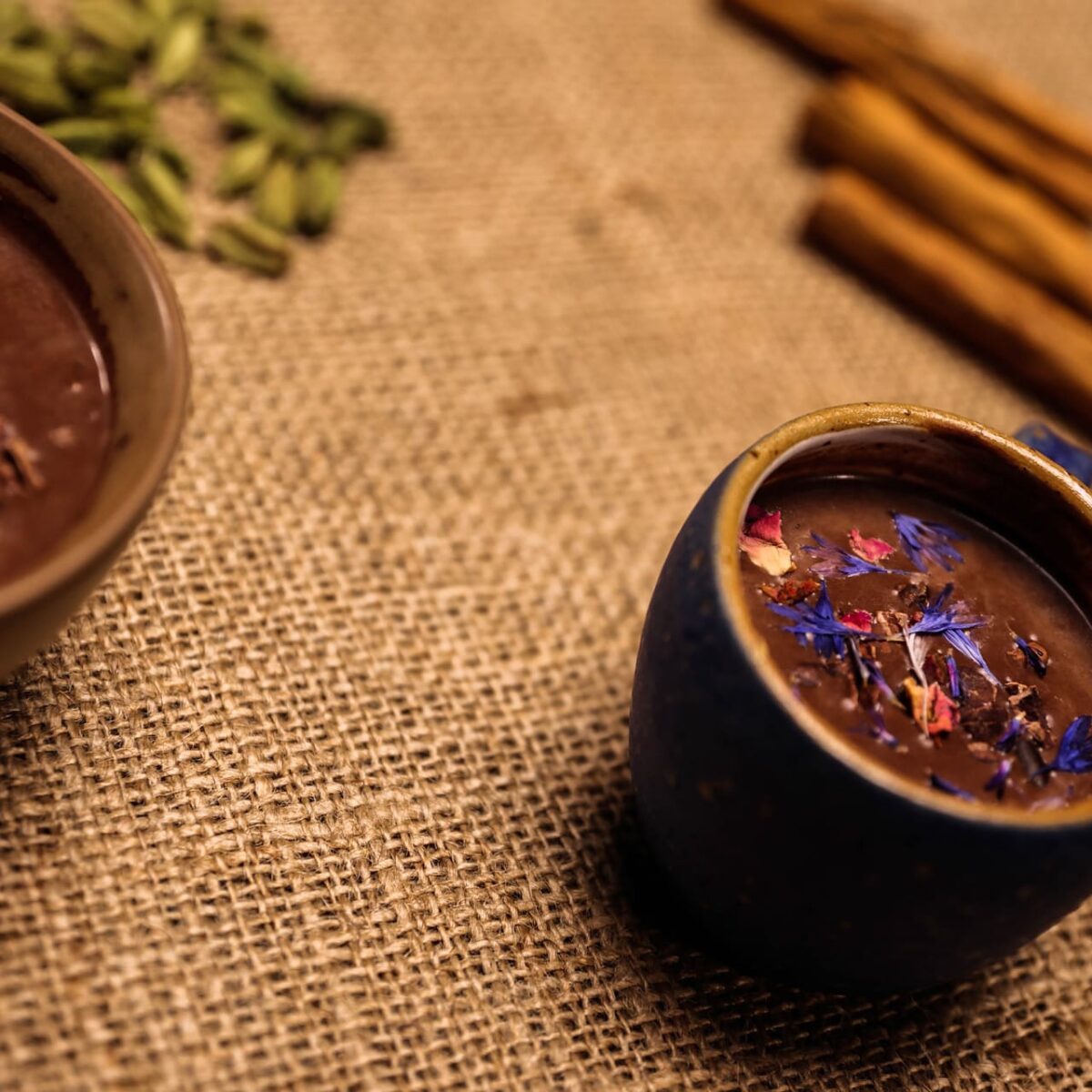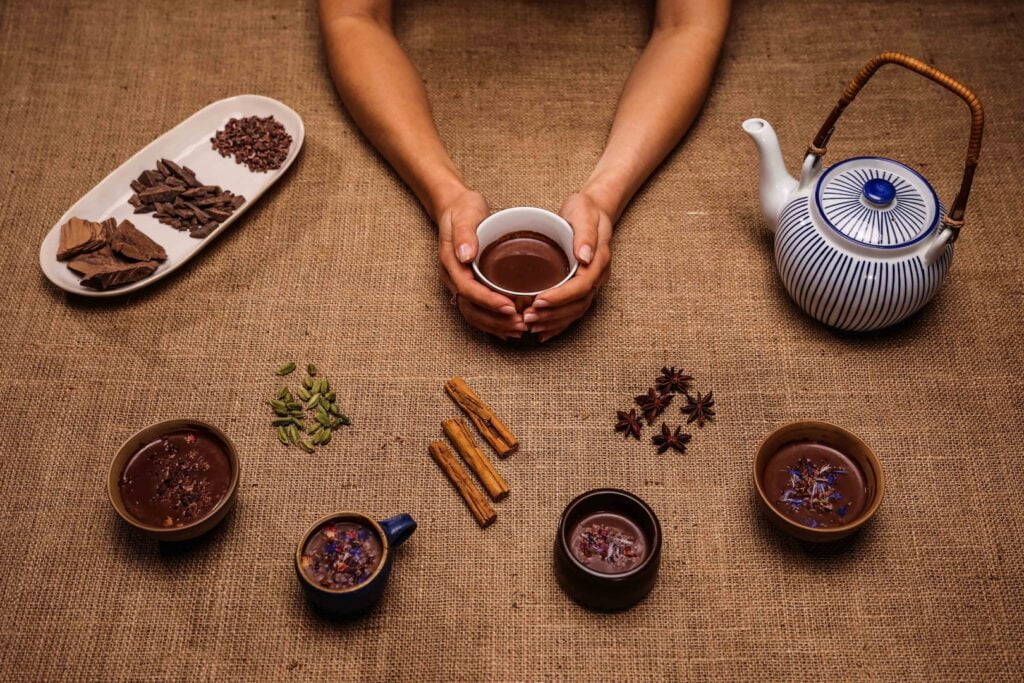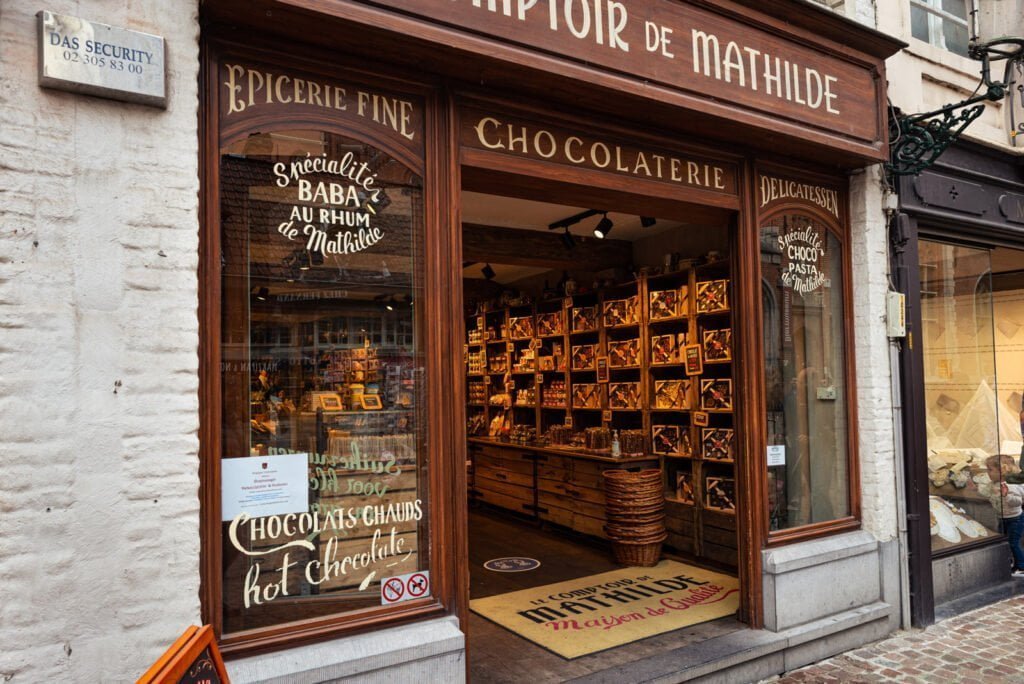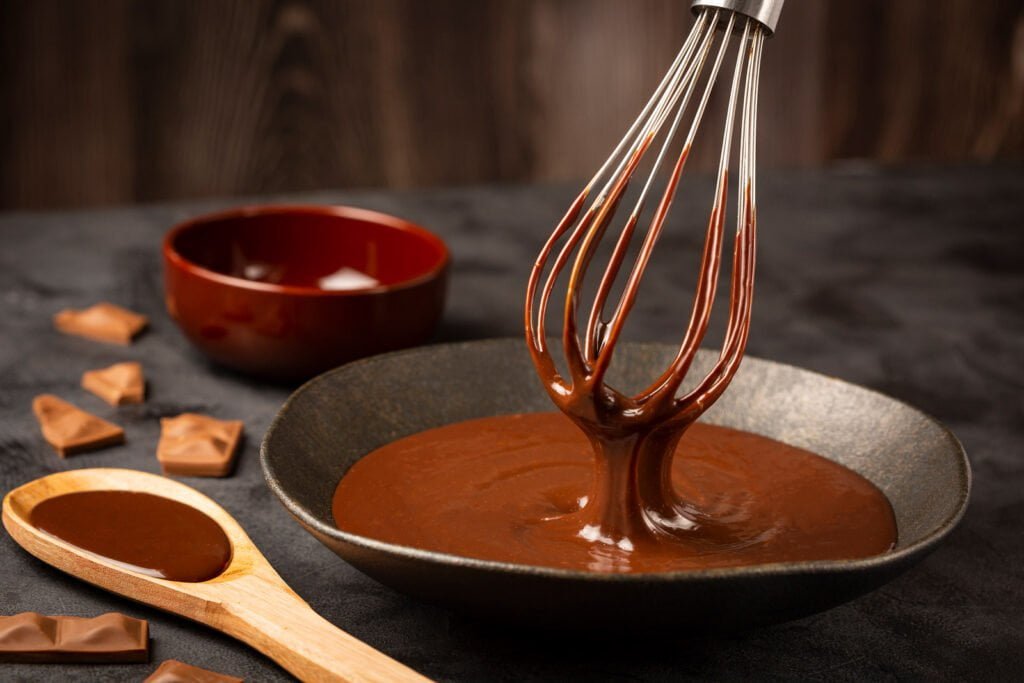Drinking chocolate – history, types, recipes

Featured products Learn more about our offer
View productsHot chocolate or hot cacao is a well-known beverage that has accompanied us for years in cafes and restaurants as a complement to a meal or a standalone treat. Liquid chocolate has also made its way into our homes: it can be prepared from special powder, chocolate chips, and bars, or from scratch, using pure cacao. Recently, this delicacy has become available in our online shop as well. Where did hot chocolate come from, what are its types, and how do you prepare it correctly?
Hot chocolate – about its long history briefly
The roots of hot chocolate can be traced back to beverages produced by the Maya and Aztecs from the Gulf of Mexico region, which were, however, cold and quite different from what we indulge in today – especially in cafes during winter. The Aztecs basically prepared two types of liquid cacao: an alcoholic beverage resembling wine made from the pulp surrounding cacao beans, and a rather bitter, cold drink made from the beans themselves. [1]. For hundreds of years, drinking chocolate was perceived as a sacred brew that imparted vigour, worthy of a great warrior who, by consuming cacao, gained even greater strength. [2]. Only after the conquistadors brought cocoa to Europe in the 16th century, with its aromas of chilli and cinnamon, did the Aztec drink change its function somewhat.t [1]. However, it did not immediately become a sweet treat for cold evenings – even in Europe, liquid chocolate was regarded as a beverage worthy of a strong man: a soldier or a gentleman. [2]. Ultimately, not without reason, the cocoa tree was assigned the Greek name Theobroma cacao – “Food of the gods”!”!


But how did the history of hot chocolate on the Old Continent begin? At first, the process of making the drink resembled a recipe practised in Mesoamerica. The cacao beans were fermented, dried and roasted, and then the shells were separated from them and crushed to form cacao paste. Such a paste, mixed with water, was the first cacao beverage known both overseas and in Europe. However, in 1828, Dutch chemist Coenraad Joahennes van Houten invented a way to separate the fats from cacao beans, thus obtaining the first cacao powder in history. This powder allowed the preparation of a beverage that is now commonly called “kakao” in Poland. Adding the fat back to the powder leads to the base of hot chocolate – and here begins the true history of the beverage that we consume to this day. [2].
The custom of drinking chocolate quickly spread throughout Europe and began to be treated as a symbol of prestige and elitism – although, interestingly, many Europeans regarded hot chocolate as a typically Catholic drink. Protestants, on the other hand, preferred to stay with coffee [2]. Interestingly, some sources suggest that the recipe for drinking chocolate originated at the court of Philip II in Spain, where its beneficial effects on health were noticed, and vanilla, cinnamon, sugar, and nuts began to be added to it. [1]. A significant step forward in the development of hot chocolate was also the replacement of water with milk, a practice that is often still done today. [3]. As you can see, the history of drinking chocolate is rich and dates back to ancient times – it’s worth adding that for a long time it was an exclusive drink in gentlemen’s clubs in Great Britain! [2]! From there, it’s not far to our times, where hot chocolate is a popular, invigorating beverage. However, chocolate houses still exist in Europe, where you can enjoy it in a slightly more exclusive setting!
Europe’s famous chocolatiers
What places to recommend to a true, dedicated hot chocolate fan? One of the first would undoubtedly be the chocolate shop de San Ginés in Madrid, opened in 1894 (!), which offers the famous Spanish churros with chocolate. The hot chocolate prepared there is reportedly unmatched, and fans of this beverage can also purchase various accessories for making chocolate and their own chocolate to prepare at home! [4]!


Another place no hot chocolate fan should miss is the “Old Chocolate House” in Bruges. Here, instead of the fantastic combination of chocolate with churros, you will encounter a whole range of possibilities that you can indulge in! Hot chocolate with milk, dark, milk, and white, with the addition of wafers or rum or amaretto, with the option of serving with foam or whipped cream… [5] there are plenty of options! If you’re a fan of drinking chocolate in various forms, be sure to visit this chocolate shop!
It would also be neglectful not to mention Angelina chocolate shop, whose origins date back to 1903. The place is still an icon of Paris today, and the drinking chocolate created there is made from a secret recipe! All that is known about the recipe is that it recommends making the drink from cocoa beans that grow in Nigeria, Ghana and the Ivory Coast – these trees are grown specifically for Angelina! The combination of beans from three countries is said to give the hot chocolate here a strong, rich flavour. Served with whipped cream, it is sure to be a memorable treat [5].
When drinking hot chocolate in these places, it is worth remembering the famous people who may have looked there in the past two centuries. Of the most famous ones, for example, we have Amelia Earhart, a famous pilot who reportedly liked to drink a cup of hot chocolate before her flights across the Pacific [6]. And speaking of oceans, many years earlier on the other side of the Atlantic, a big fan of drinking chocolate was also reportedly Thomas Jefferson, one of the founding fathers of the United States [7]!
Types of hot chocolate


In our shop, we currently offer several types of drinking chocolate: a slightly more dry chocolate with a high cacao content and natural rum flavouring, milk chocolate and white chocolate. This offer will, of course, be expanded in the future!
As for dark chocolate, it functions as a beverage analogous to its bar version. With the highest content of pure cacao, dark drinking chocolate is not very sweet, but aromatic and wholesome. An absolute must-have for rigorous fans of real cacao!
The more classic variant is, of course, milk chocolate for drinking, still rich in cocoa and suitable not only for drinking, but also for munching or making the truest chocolate coating. Hot, milk chocolate has a lighter taste than its cousin, dark chocolate – so it’s more dessert-like, and its lower fat content means we can enjoy it as a meal accompaniment or between meals without the risk of overeating.
Finally, there is also a drink to satisfy fans of white chocolate bars. White drinking chocolate resembles its milky big brother in content, but differs in flavor and aroma. Creamy and light, it is sure to meet the tastes of fans of alternative treats containing cacao. Like milk chocolate, it can also be crunched or made into a candy coating.
It is also worth mentioning here a type of drinking chocolate, which we do not have in our store at the moment (although we are working on it!). We are talking about pink hot chocolate, an invention that is only 5 years old! Prepared from the beans of the Ruby cacao tree, which grows in the Ivory Coast, pink chocolate not only has a different color but also a different taste and aroma [8] – it is slightly fruity and slightly more acidic than traditional chocolate [9]. The development of the pink chocolate recipe took a whole 10 years, and it is the first new type of chocolate bar since the discovery of the white chocolate production method! Perhaps we will soon find out for ourselves what this innovative marvel tastes like.
Hot chocolate – recipes
Finally, the best part – that is, the recipes! Once you’ve purchased your hot chocolate, it’s time to make it in your four walls – whether for yourself, guests or your partner and children. How do you go about it? Use water or milk? How long to heat the drink? We explain!
Classic hot chocolate
About 20g of chocolate (the more, the more intense the flavour will be!) put into a mug and pour 200ml of heated, but not boiled, milk. Mixing and ready!
Hot chocolate the Spanish way
At the very beginning, whisk 1 teaspoon of corn flour with 1 tablespoon of milk until it reaches the consistency of a paste. To 250ml of hot (but not boiling!) milk add 20g of chocolate, 1 teaspoon of cinnamon and the resulting paste. Heat until the drink doesn’t thicken – and you’re done! [3]
Hot chocolate on water – diet version
A slightly less caloric option for hot chocolate fans is chocolate made with water – it is slightly less dense and creamy and more dry [10]. To prepare such chocolate, first heat 250 ml of water and dissolve 20g of chocolate in it. The flavour and aroma of the drink should be complemented with cinnamon, vanilla or nuts!
